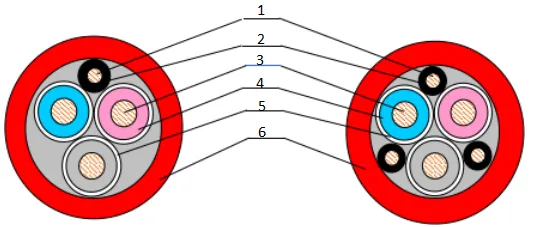11 月 . 03, 2024 00:58 Back to list
multi-core cable wire
Understanding Multi-Core Cable Wires A Comprehensive Overview
Multi-core cable wires are indispensable components in electrical engineering, telecommunications, and various industrial applications. Their design and functionality significantly enhance the efficiency and reliability of signal transmission and power distribution. In this article, we will delve into what multi-core cables are, their advantages, applications, and the considerations for selecting the appropriate type.
What is a Multi-Core Cable Wire?
A multi-core cable consists of multiple conductive wires bundled together within a single outer sheath. Each core is insulated individually, which prevents short circuits and crosstalk between the wires. These cables can vary in size, insulation material, and number of cores, making them versatile for different applications. The cores can also be made of different metals, such as copper or aluminum, depending on the required conductivity and budget.
Advantages of Multi-Core Cables
1. Increased Flexibility Multi-core cables provide remarkable flexibility compared to single-core cables. This flexibility is particularly advantageous in applications where the cables need to move or bend frequently.
2. Space Efficiency Using a multi-core cable can reduce the amount of cable space needed in tight or confined spaces. Instead of installing multiple single-core wires, a single cable can handle several circuits.
3. Reduced Noise Interference The design of multi-core cables often minimizes electromagnetic interference. The twisted pairs or twisted cores help to cancel out electrical noise, ensuring better signal integrity over long distances.
4. Simplified Installation With fewer individual cables to manage, installation becomes more straightforward. This reduction in complexity can save both time and labor costs during the setup of electrical systems.
Applications of Multi-Core Cables
Multi-core cables are widely utilized across various industries. Here are some common applications
- Telecommunications Used extensively in telephone lines and internet connections, multi-core cables facilitate the efficient transmission of data and voice signals.
multi-core cable wire

- Industrial Machinery In manufacturing and industrial settings, multi-core cables connect different parts of machines, sensors, and control systems
.- Broadcasting In radio and television broadcasting, multi-core cables are employed for transmitting audio and video signals to ensure high-quality output.
- Home Appliances Many household appliances utilize multi-core cables for power distribution, enhancing safety and functionality.
Considerations When Choosing Multi-Core Cables
When selecting a multi-core cable, several factors should be considered
1. Core Count The number of cores needed depends on the specific application. Determine how many circuits you need to connect before making a decision.
2. Cable Rating Always check the voltage and current ratings to ensure the cable can handle the electrical load without overheating.
3. Environmental Conditions Evaluate where the cable will be used. For outdoor or harsh environments, select cables with appropriate insulation and protection against moisture, chemicals, and UV radiation.
4. Compliance and Standards Always choose cables that comply with local and international standards for safety and performance.
Conclusion
In summary, multi-core cable wires are crucial for efficient and effective electrical and data communication in various sectors. Their advantages in flexibility, space efficiency, and noise reduction make them a preferred choice for many applications. By understanding their characteristics and selecting the appropriate type, businesses and individuals can benefit from enhanced connectivity and operational efficiency. Whether in telecommunications, industrial use, or home applications, multi-core cables are a vital element in modern technology infrastructure.
Share
-
Understanding the Differences Between Wafer Type Butterfly Valve and Lugged Butterfly ValveNewsOct.25,2024
-
The Efficiency of Wafer Type Butterfly Valve and Lugged Butterfly ValveNewsOct.25,2024
-
The Ultimate Guide to Industrial Swing Check Valve: Performance, Installation, and MaintenanceNewsOct.25,2024
-
Superior Performance with Industrial Swing Check Valve: The Essential Valve for Any SystemNewsOct.25,2024
-
Industrial Swing Check Valve: The Ideal Solution for Flow ControlNewsOct.25,2024
-
You Need to Know About Industrial Swing Check Valve: Functionality, Scope, and PerformanceNewsOct.25,2024